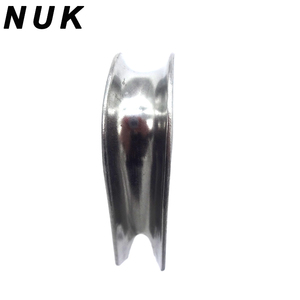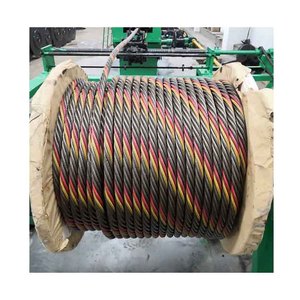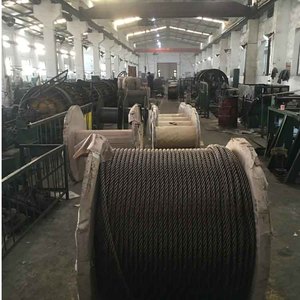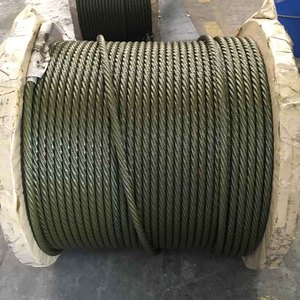
All categories
Featured selections
Trade Assurance
Buyer Central
Help Center
Get the app
Become a supplier

(5407 products available)































Stainless steel wire rigging is manufactured in several types. They include the following:
Aircraft Control Cables
These stainless steel cables are built for precision and reliability in controlling aircraft components. Usually, they are made with corrosion-resistant 17-4 PH material to ensure longevity in harsh flight conditions. The rigging wire typically comes in diameters of 1/16, 3/32, and 1/8 inches with tighter tolerances for smooth operation. Their lightweight construction minimizes added weight without compromising strength, crucial for the sensitive control systems in aviation.
Marine Rigging Wire
This rigging wire is especially suited for saltwater environments. It provides unmatched resistance to corrosion due to its marine-grade stainless steel composition, often 316 or 304 grades. The wire is customizable to lengths and diameters according to the needs of boating and shipping enterprises. Usually, it is primarily used for standing rigging, lifelines, and other critical safety applications. Common diameters include 1/8, 5/32, and 3/16 inches. 316 wire is ideal for coastal and saltwater application as it offers superior corrosion resistance.
Architectural Cable Rigging
Apart from providing structural support, the stainless steel wire also serves as an aesthetic component in modern architecture. Ideally, it is fabricated from high-quality stainless steel grades such as 304 and 316 for durability and resistance to environmental elements. Common diameters range from 1/8 to 1/2 inch, depending on the load-bearing requirements and design intent. It comes with the additional benefit of being low maintenance while retaining a sleek and contemporary appearance.
Industrial Applications
The high tensile strength and durability of stainless steel wire makes it ideal for heavy-duty applications in the industrial sector. Often, it is made from high-strength grades such as 301 and 302. Common diameters range from 0.045 to 0.5 inches, depending on the specific load and usage requirements. Features include resistance to chemicals, heat, and wear, making it well suited for use in harsh industrial environments.
Construction and Suspension Systems
Often, stainless steel wire is utilized in critical load-bearing applications in construction, such as suspension bridges and cable-stayed structures. Usually, it is constructed from 304 and 316 grades which provide a good balance between strength and resistance to environmental degradation. Standard diameters range from 1/4 to 3/8 inches with customized sizes available for particular engineering needs. In addition, the long-lasting and low-maintenance nature makes it an ideal option for long-term structural integrity and safety.
Stainless steel wire rigging has myriad features. They include:
Corrosion Resistance
The ability of stainless steel wire rigging to withstand rust and corrosion is one of its major benefits. Usually, it is made with a combination of steel and nickel, which makes it resistant to moisture and difficult environments. Often, marine-grade wire (316 stainless steel) offers unparalleled resistance to saltwater, making it ideal for marine and coastal settings. Also, the rigging wire is designated for architectural applications. It also stores up on the same corrosion resistance due to its typical exposure to outdoor elements.
High Strength and Durability
Normally, stainless steel wire rigging is extremely strong, often capable of bearing massive loads with ease. Beyond that, this rigging wire is manufactured to endure heavy strains and tensions in various applications, from marine rigging to construction. This maintains integrity and safety under normal and adverse conditions. Additionally, it comes with a long lifespan due to its toughness, cutting down the need for frequent replacements.
Flexibility and elasticity
Also, stainless steel wire rigging offers an essential degree of flexibility. This enables it to be tensioned securely without snapping. Also, its elasticity helps the rigging absorb shocks and loads, which in turn minimizes the risk of failure in critical applications. In addition, the wire's flexibility allows easy handling and installation in complicated designs.
Low Maintenance
Stainless steel wire rigging requires little upkeep. Ideally, this makes it a practical choice in difficult-to-reach areas or where regular inspections are hard to carry out. Often, unlike other materials that may need frequent coating or replacement, stainless steel maintains its structural integrity without necessitating regular care. This can save costs as well as time in the long run.
Aesthetic Appeal
Normally, stainless steel wire has a contemporary, sleek appearance making it a popular option for decorative and functional purposes alike. This is common in architectural applications where visual appeal is as important as structural functionality. Also, it does not tarnish and rather retains a polished look over time.
Buyers should consider the following when purchasing stainless steel wire rigging.
Grade of Stainless Steel
Both 304 and 316 grades of stainless steel are quintessential when it comes to rigging wires. 304 is suitable for general uses, which include architectural applications. 316, on the other hand, is designed for marine and chemical environments as it contains molybdenum for additional corrosion resistance. In addition, buyers should consider the specific environmental conditions the wire will encounter in order to select the right grade.
Diameter and thickness
Stainless steel wires are manufactured in varying diameters, usually ranging from 1/16 to 1/2 inches. Ideally, larger diameters provide more strength and are suitable for heavy-duty applications. On the flip side, smaller diameters offer flexibility and are ideal for lighter loads. Business owners should stock various thicknesses to cater to customers’ distinct needs depending on the load-bearing capacity required.
Tensile strength
Actually, tensile strength is a key consideration when selecting rigging wire. Normally, higher tensile strength equals greater loads the wire can support without breaking. Additionally, this is particularly critical in construction, marine, and industrial applications where safety and performance are paramount. To get the correct tensile strength, it would be prudent to liaet with the manufacturer to ensure the wire meets the required standards.
End fittings and terminations
Buyers should look for compatibility between the end fittings and terminations with the overall rigging setup. Usually, common options include swaged, threaded, and mechanical fittings. Also, they should ensure the termination methods maintain the wire’s strength and integrity. Stock various fittings to offer customers complete rigging solutions.
Application requirements
Business owners should consider the specific use of their customers. Usually, requirements differ depending on whether the wire is for marine, industrial, or architectural use. Furthermore, buyers should look into customer needs by considering load ratings, environmental factors, and industry standards. Thus ensuring suitability for a particular application.
Code and standards
Each stainless steel wire rigging is developed based on specific industry standards and regulations. Normally, these include the American Boat and Yacht Council (ABYC) standards for marine applications. Therefore, buyers should be aware of these standards to help them select wires that meet the necessary safety and performance requirements.
The stainless steel wire rigging has varied uses. They include:
Marine Applications
Marine-grade stainless steel wire rigging has wide usage in sailing and boating industries. Usually, it is critical for the tension and structural integrity of sails, masts, and rigging. In addition, a standard use includes replacing old rigging where the wire is cut to length using a cable cutter. The ends are then secured using special fittings and a swaging tool to create strong, safe connections. Also, maintenance includes regular inspections for signs of corrosion, wear, or fatigue. This is commonly accompanied by periodic tightening to ensure continued safety and performance.
Construction and Engineering
Often, in construction, stainless steel wire rigging works as key components in suspension bridges, roofs, and other structures. Additionally, it is primarily used to provide tension and support in these applications. In addition, replacing worn-out cables or installing new ones requires skills. Also, using the wrong diameter can result in loads being unevenly distributed. Maintenance involves checking for signs of stretching or deformation and retightening cables as necessary to maintain structural integrity.
Industrial Hoisting and Lifting
Usually, in industrial settings, rigging wire is common in lifting and hoisting equipment. This usually includes cranes and forkhoppers. Ideally, its high tensile strength means it can handle extremely heavy loads. Also, it is crucial to properly install and secure the wire when setting up rigging for heavy lifting. They prevent accidents and failure. Moreover, regular inspection for wear, fraying, or kinking is critical in maintaining safety. This must be done before each usage.
Aesthetic and Architectural Applications
Customarily, stainless steel rigging wire has frequent use in architectural applications. Particularly in facades, canopies, and balustrades. Moreover, its sleek appearance complements modern design while offering resilience. Typically, stainless steel rigging wire is an ideal companion for installing glass canopies. They provide support without obstructing views since they are virtually transparent. Often, after installation, minimal maintenance is required. Commonly, routine cleaning and inspections suffice to ensure the rigging remains secure and free from corrosion.
Stainless steel wire rigging has assorted pros and cons. Here are some of them:
Corrosion Resistance
One of the crucial benefits of stainless steel wire rigging is its corrosion resistance. Usually, the alloying elements of nickel and chromium offer it unrivaled protection against rust and corrosion. This is especially critical in marine environments where saltwater exposure can rapidly degrade other types of metal. Therefore, in addition to its strength, it makes stainless steel an ideal choice for long-term outdoor applications.
High Strength and Durability
Stainless steel wire rigging is renowned for its high tensile strength. Commonly, it can bear large loads without stretching or breaking. Whether in construction, sailing, or industrial settings, its durability ensures long-lasting performance even under strenuous conditions. Additionally, it can withstand temperature variations, which means it is suited for multiple environments.
Low Maintenance
Usually, it requires less maintenance compared to other materials. Often, while some metals necessitate regular painting or protective coatings to prevent deterioration, stainless steel generally does not require such treatments. Instead, occasional cleaning is sufficient to maintain its appearance and functionality. This saves time and money in the long run, making it a cost-effective choice.
Aesthetic Appeal
Stainless steel wire rigging comes with a contemporary, sleek appearance. This makes it an appealing option for architectural and aesthetic applications alike. Often, it is polished finish does not only resist tarnishing but also gives a shiny, attractive outlook. Therefore, this enhances the overall visual appeal of structures.
Initial Cost
The costs incurred when purchasing stainless steel wire rigging are comparatively higher than those of traditional steel or other materials. Although, the long-term benefits may outweigh the costs, the upfront price can be a deterrent. Sometimes, budget-sensitive projects prefer more affordable options despite their requiring frequent maintenance.
Difficulty in Shaping and Cutting
Inevitabley, it is harder to work with compared to softer metals like carbon steel when creating custom fittings or alterations. Moreover, specialized tools are essential for cutting and shaping, which can add to project costs. Therefore, these challenges might delay depending on the availability of resources needed for installation.
Brittleness at Low Temperatures
Normally, while stainless steel is durable under normal conditions. Ideally, it becomes brittle when exposed to extreme low temperatures. This makes it less suitable for environments that experience significantly cold weather. In addition, these conditions can compromise the integrity and performance of the rigging. This is a huge disadvantage, especially in cryogenic applications.
Both 304 and 316 stainless steel rigging were designed for distinct purposes. Grade 304 is common in general use due to its moderate corrosion resistance and affordability. On the other hand, grade 316 is frequent in marine and chemical industries due to its superior corrosion resistance since it contains molybdenum. Therefore, 304 is used in the construction and architectural sectors. Conversely, 316 is in marine, chemical, and medical applications.
Maintenance of the rigging wire depends on the particular environment. Usually, the rigging wire should be cleaned periodically to remove debris, salt, or other contaminants. This is more so in marine environments where exposure to saltwater is common. Additionally, using a soft brush and fresh water is sufficient to prevent the build-up of corrosive elements. Besides, a corrosion-resistant lubricant can be applied to pulleys and blocks to ensure smooth operation. Further regular inspections for signs of wear or corrosion are critical. This is to ensure any issues are identified before they affect performance.
Normally, it is used in diverse sectors due to its strength and corrosion resistance. Commonly, in marine industry, it offers vital support in sailing vessels and other watercraft. Often, in construction, it serves as a tension cable in bridges and architectural designs. Besides, it also finds frequent use in industrial settings for hoisting and lifting machinery. Additionally, in the racing industry, it is critical for safety harnesses and other load-bearing components.
Buyers must consider the project’s environmental conditions. These include exposure to chemicals, humidity, or extreme temperatures. Usually, they should evaluate the required tensile strength and diameter based on load-bearing specifications. Moreover, the wire should meet industry standards and certifications for safety and performance. Finally, they must select suitable fittings and terminations to ensure compatibility and structural integrity.